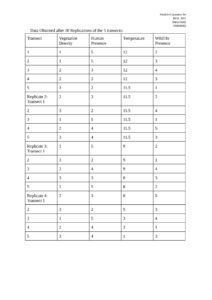I collected data on March 14th, 2024, amid a high of 12.4 C and a low of -0.9C, I aimed to scrutinize the interconnections among vegetation density, human presence, temperature fluctuations, and wildlife presence around the focal point of a sweet chestnut tree in my backyard.
Sampling Design:
Building upon the outlined experimental design, a meticulous sampling strategy was executed. Employing stratified random and systematic sampling methods, the study area was stratified based on vegetation density and human activity levels. This facilitated a thorough examination of the ecological landscape surrounding the sweet chestnut tree.
Data Collection:
Navigating the intricacies of the backyard terrain, data collection commenced methodically. Each designated sampling point was meticulously assessed for vegetation density, human presence, and temperature variations.
Vegetation Density (Ordinal Variable 1-5):
1: Sparse vegetation, predominantly bare ground with minimal plant cover.
2: Low vegetation density, scattered plants with gaps between them.
3: Moderate vegetation density, some areas with denser plant growth but still some gaps.
4: High vegetation density, most areas covered with vegetation, minimal gaps.
5: Very high vegetation density, dense and lush vegetation covering almost all available space.
Rationale: Using a 1-5 scale allows for a graded assessment of vegetation density, ranging from sparse to dense. This scale captures the variation in plant cover and provides a standardized method for quantifying vegetation density across different sampling points.
Human Presence (Ordinal Variable 1-5):
1: No human activity observed, undisturbed natural environment.
2: Minimal human presence, occasional passerby or distant human activity.
3: Low human presence, occasional human activity in the vicinity.
4: Moderate human presence, frequent human activity nearby.
5: High human presence, and constant human activity directly impacting the study area.
Rationale: Human presence can have varying degrees of impact on wildlife behaviour and habitat use. Using a 1-5 scale allows for the classification of human presence levels, ranging from minimal disturbance to significant human impact, providing insight into potential anthropogenic influences on wildlife.
Temperature (Ordinal Variable 1-5):
1: Extremely cold temperatures, near freezing or below.
2: Cold temperatures, chilly but above freezing.
3: Moderate temperatures, comfortable and mild.
4: Warm temperatures, pleasantly warm but not hot.
5: Hot temperatures, uncomfortably warm or sweltering.
Rationale: Temperature fluctuations can influence wildlife activity and habitat preferences. Using a 1-5 scale allows for the classification of temperature ranges, ranging from cold to hot, providing insight into potential temperature-related effects on wildlife presence and behaviour.
By using a 1-5 point basis for each variable, you create a standardized framework for assessing and comparing the factors influencing wildlife presence around the sweet chestnut tree. This allows for a systematic evaluation of vegetation density, human presence, and temperature, providing a comprehensive understanding of their potential impact on wildlife dynamics in the backyard ecosystem. Before implementing the stratified sampling method, I conducted preliminary assessments to delineate vegetation density and human activity levels within the study area surrounding the sweet chestnut tree. Based on visual observations and prior knowledge of the site, I identified three strata for each variable:
Vegetation Density Strata:
-Sparse Vegetation
-Moderate Vegetation
-Dense Vegetation
Human Activity Strata:
-Low Human Presence
-Moderate Human Presence
-High Human Presence
Measurement and Identification of Strata:
To determine the levels within each stratum, I conducted on-site measurements and observations. For vegetation density, I quantified the amount of plant cover using a visual estimation method, assigning each stratum based on the percentage of ground covered by vegetation. Similarly, for human activity levels, I assessed the frequency and intensity of human presence through visual observations and recorded anecdotal evidence of human activities in the vicinity.
Systematic Sampling Approach:
With the strata identified, I will employ a systematic sampling approach to ensure comprehensive coverage of the study area. Here’s the protocol for systematically collecting data at each sampling point:
Transect Establishment:
-Divide the study area into five transects radiating out from the sweet chestnut tree, each representing a different stratum combination of vegetation density and human activity levels.
Sampling Point Selection:
-Within each transect, systematically select sampling points at regular intervals to ensure even coverage of the strata.
-Utilize a predetermined sampling interval (e.g., every 5 meters) to systematically choose sampling points along the transect.
Data Collection Procedure:
At each sampling point, record the following variables:
-Vegetation Density: Assess the amount of plant cover within a defined area around the sampling point and assign the corresponding stratum.
-Human Activity: Observe and document the frequency and intensity of human presence in the vicinity of the sampling point, assigning the appropriate stratum based on the level of activity.
-Temperature: Utilize a handheld thermometer to measure the ambient temperature at the sampling point.
-Wildlife Presence: Rate the presence of wildlife on a scale of 1-5, based on visual observations and/or evidence of wildlife activity (e.g., tracks, droppings, sightings).
Date and Weather Conditions:
March 14th, 2024, witnessed fluctuating weather conditions of light precipitation and cloud, with temperatures ranging from a high of 12.4°C at 4:00 PM to a low of -0.9°C at 7:00 AM. I began conducting trials at 4:05 PM and ended at 6:45 PM.
Data obtained:

Similar to my comments on previous blog posts and small assignments, you will not be able to draw any conclusions from your study if you only have 1 chestnut tree. If you sample over time that gives you some replication but you still have to be careful about your conclusions without more than 1 tree.